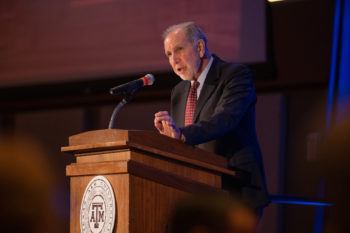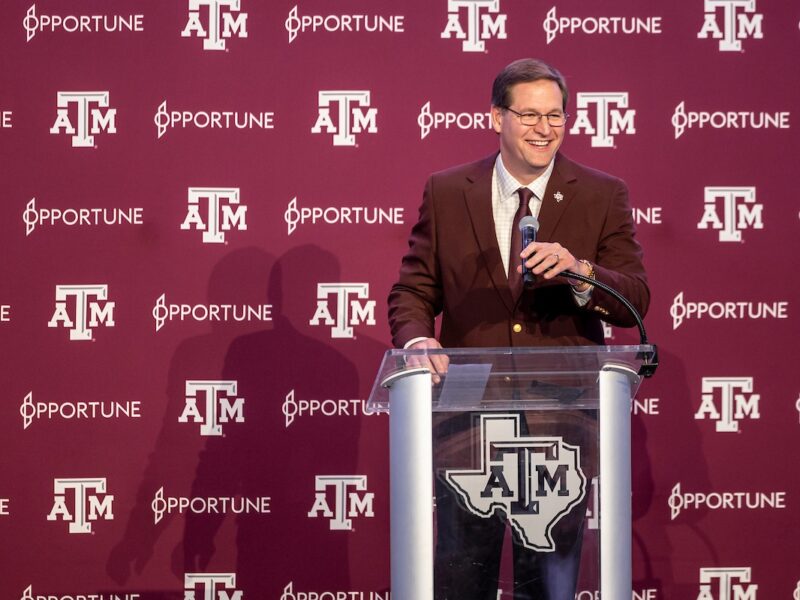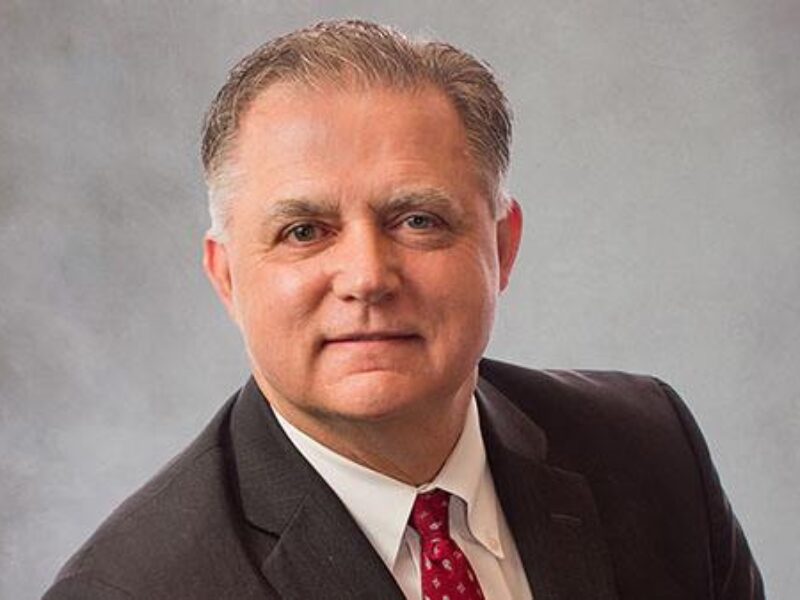Michael K. Young To Retire From Post As 25th President Of Texas A&M University

Texas A&M University President Michael K. Young on Wednesday announced his retirement from serving as the top administrator over one of the largest universities in the country.
The longtime leader in higher education will officially step down May 31, 2021, but will continue as a tenured faculty member at the Texas A&M Law School, as well as at the Bush School of Government and Public Service, where he will become the first director of the Institute for Religious Liberties and International Affairs. In these positions, Young will lend expertise he cultivated while working three decades ago in the Bush administration, as well as eight years on a federal commission that deals with religious freedom internationally.
An estimated 71,200 students, 3,200-plus faculty and more than 7,390 staff members received an email from Young early Wednesday, saying he will continue to focus on established priorities at the university, while preserving its core educational mission and ensuring A&M is well situated to continue its “extraordinary progress” as a world-class educational institution.
“In this academic year we face unusual challenges,” he wrote. “Yet, we will continue to provide transformational learning opportunities for all our students, as well as produce remarkable discoveries that improve the lives of the people of Texas and our country.”
‘Tremendous Service’
Texas A&M System Board of Regents Chairman Elaine Mendoza described Young as a “transformational leader, contributing to a rise in Texas A&M’s national and international reputation as a global Tier 1 research institution while meeting the growing needs of the citizens of Texas.”
“Of particular note is his work toward student retention, helping those who come to Texas A&M succeed in fulfilling Texas A&M’s mission to graduate leaders who selflessly serve,” she said.
Earlier this year, Young told the Texas A&M University System Board of Regents and Chancellor John Sharp about his plans to transition onto the faculty.
Sharp, who hired Young five years ago, thanked A&M’s 25th president for his “tremendous service” to Texas A&M.
“When we recruited him, we wanted him to help Texas A&M become the best public university in the country and we have made great strides in doing so under his leadership,” Sharp said. “We appreciate his service and look forward to recognizing his achievements in the months to come.”
Young’s many accomplishments include a significant rise in rankings, expansion of Tier 1 research, remarkable success in the ambitious $4 billion Lead by Example fundraising campaign and recruiting additional high-caliber faculty. What Young said he has cherished most is working daily with “our exceptional students and our dauntless faculty and staff.”
Other highlights include the following:
- Research expenditures have risen almost 13 percent from $854 million prior to his arrival to $965 million in 2019.
- More than 450 faculty members have been hired since 2015.
- The Student Success Initiative was started by Young to help students stay in college, succeed and graduate. Retention has gone from 89 percent in his first year to 94 percent this year, while four-year graduation rates have moved up four points to 58.6 percent during the same period.
- His President’s Excellence Fund is a 10-year, $100 million fund to unlock opportunities across colleges, divisions and faculty in collaborating on research. The first two rounds have yielded $11.6 million in additional external funding to date.
- A&M expanded campuses into South Texas and Washington, D.C.: The McAllen Higher Education Center opened to serve one of the fastest growing areas in the nation, while the Bush School recently announced the upcoming opening of a teaching site in the nation’s capital.
- Almost 2 million square feet of building space was added on the flagship campus with the vast majority tied to academics, including the Zachry Engineering Education Complex, Student Services Building, Music Activities Center, Veterinary and Biomedical Education Complex and the Innovative Learning Classroom Building, among others. Several athletic facilities also came online, including the E.B. Cushing Track and Field Stadium and the Davis Diamond softball complex.
- Texas A&M improved in national and international rankings over the past five years, with the most recent being from Money Magazine, which said A&M was No. 1 in Texas and 11th in the country for affordability and best value. The Mays Business School moved into the Top 10 (9th) public programs in the U.S. The Law School jumped 100 places in the last five years, rising 23 spots last year alone, making it the largest increase of any school in the Top 100.
Asked about these achievements, Young diverted any credit.
“When I think about all that we’ve been able to accomplish, I attach a name or see someone else’s picture alongside each of these actions,” Young said. “I’ve been incredibly fortunate to have an outstanding senior leadership team — I can’t them thank enough.”
Veteran Public Servant
Young came to Texas A&M after serving as president at two nationally recognized colleges: First at the University of Utah, where he was a distinguished professor of law, and the University of Washington, where he launched the Global Innovation Exchange, which was a partnership in the State of Washington between the University of Washington, a major Chinese university and European universities.
Prior to that, he was dean and Lobingier Professor of Comparative Law and Jurisprudence at the George Washington University Law School, and was a professor at Columbia University for more than 20 years. He also was a visiting professor and scholar at three universities in Japan.
The Harvard Law School graduate has spent his life in public service, including as a law clerk to the late U.S. Supreme Court Chief Justice William H. Rehnquist; deputy undersecretary for economic and agricultural affairs; and ambassador for trade and environmental affairs in the Department of State during President George H.W. Bush’s administration. Young worked on many international agreements, including treaties related to German unification, as well as the North American Free Trade Agreement and Uruguay Round negotiations leading to the World Trade Organization.
He also served eight years on the U.S. Commission on International Religious Freedom, which he chaired on two separate occasions.
It’s no coincidence that Young is returning to his scholarly roots when he heads back into a law school classroom, while overseeing the Institute for Religious Liberties at the Bush School.
“It’s been a privilege to be a part of this exceptional university,” he said in between interviews with reporters Wednesday afternoon. “I’m looking forward to continuing in a different capacity by being able to really dig deep into these subject matters and issues.”
But that is what’s next for Young — not now.
“I am looking forward to the next nine months — we have a great deal of work to focus on this semester and next,” Young said.
A search committee will submit at least three candidates to the Board of Regents, with the goal being to name Young’s successor by June 1, 2021.
Media contact: Kelly Brown, kelly.brown@tamu.edu





